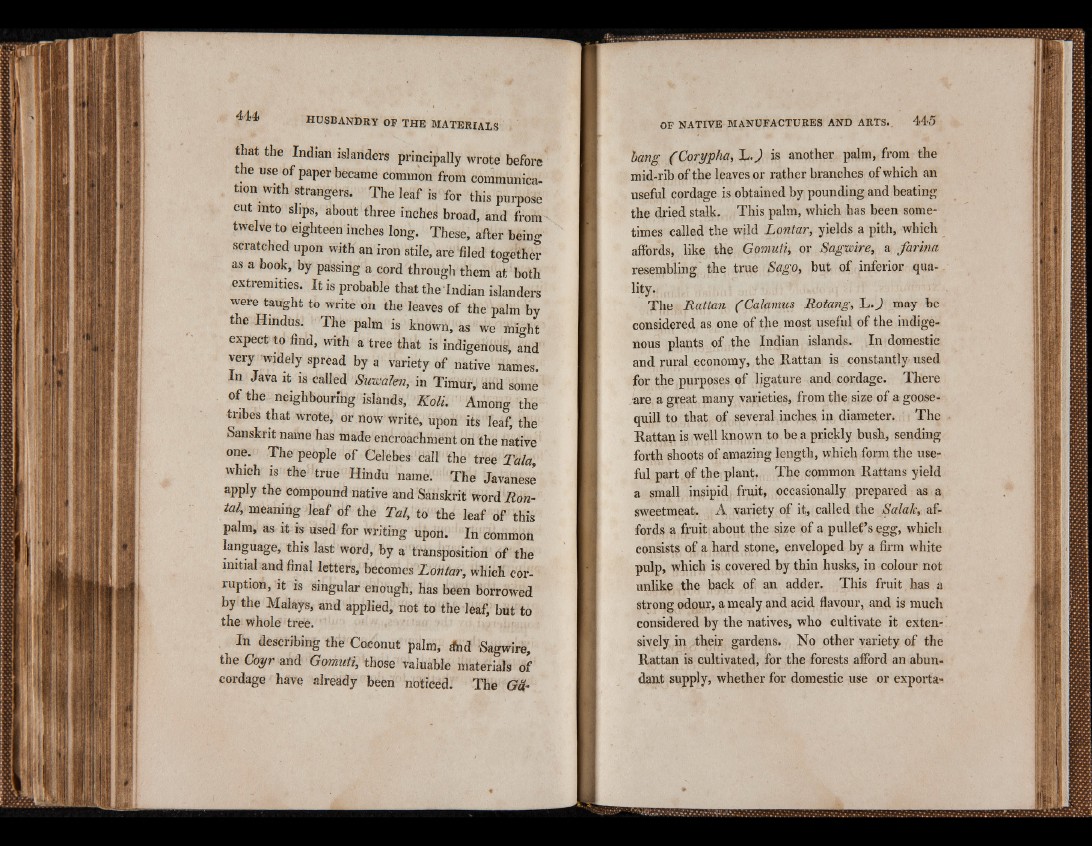
that the Indian islanders principally wrote before
the use of paper became common from communication
with strangers. The leaf is for this purpose
cut into slips, about three inches broad, and from
twelve to eighteen inches long. These, after being
scratched upon with an iron stile, are filed together
as a book, by passing a cord through them at both
extremities. It is probable that the indian islanders
were taught to write on the leaves of the palm by
the Hindus. The palm is known, as we might
expect to find, with a tree that is indigenous, and
very widely spread by a variety of native names,
n Java it is called Suwalen, in Timur, and some
of the neighbouring islands, KolL Among the
tribes that wrote, or now write, upon its leaf, the
Sanskrit name has made encroachment on the native
one. The people of Celebes call the tree Tala,
which is the true Hindu name. The Javanes^
apply the compound native and Sanskrit word Ron-
tal, meaning leaf of the Tal, to the leaf of this
palm, as it is used for writing upon. In common
language, this last word, by a transposition of the
initial and final letters, becomes Lontar, which corruption,
it is singular enough, has been borrowed
by the Malays, and applied, not to the leaf, but to
the whole tree.
In describing the Coconut palm, änd Sagwire,
the Coyr and Gomuti, those valuable materials of
cordage have already been noticed. The Gäbang
( Corypha, L .J is another palm, from the
mid-rib of the leaves or rather branches of which an
useful cordage is obtained by pounding and beating
the dried stalk. This palm, which has been sometimes
called the wild Lontar, yields a pith, which
affords, like the Gomuti, or Sagwire, a farina
resembling the true Sago, but of inferior quality..
The Rattan ( Calamus Rotang, L .J may be
considered as one of the most useful of the indigenous
plants of the Indian islands. In domestic
and rural economy, the Rattan is constantly used
for the purposes of ligature and cordage. There
are a great many varieties, from the size of a goose-
quill to that of several inches, in diameter. The
Rattan is well known to be a prickly bush, sending
forth shoots of amazing length, which form the useful
part of the plant. The common Rattans yield
a small insipid fruit, occasionally prepared as a
sweetmeat. A variety of it, called the Salak, affords
a fruit about the size of a pullet’s egg, which
consists of a hard stone, enveloped by a firm white
pulp, which is covered by thin husks, in colour not
unlike the back of an adder. This fruit has a
strong odour, a mealy and acid flavour, and is much
considered by the natives, who cultivate it extensively
in their gardens. No other variety of the
Rattan is cultivated, for the forests afford an abundant
supply, whether for domestic use or exporta